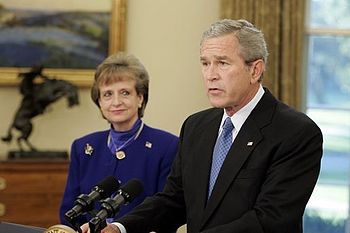George W. Bush Supreme Court candidates
The number of close votes in cases involving these areas suggests that a change of one or two key justices could completely shift the thinking of the Court on such issues.
When asked about the kind of justices he would appoint to the Supreme Court, President George W. Bush responded: "I would pick people that would be strict constructionists.
In more detail, Bush in 1999 told reporter Fred Barnes of the conservative magazine The Weekly Standard that he would nominate judges to the court in the mold of originalist Justice Antonin Scalia.
[3] Soon after President Bush's first inauguration in January 2001, many liberal academics became worried that he would begin packing the federal judiciary with conservative jurists.
Yale law professor Bruce Ackerman, writing in the February 2001 edition of The American Prospect, encouraged the use of the filibuster to stop Bush from placing any nominee on the Supreme Court during his first term.
[10] However, after the 2002 mid-term elections in which the Republicans regained control of the Senate by a 51–49 margin, these same nominees began to be moved through the now Republican-controlled Judiciary Committee.
With President Bush winning re-election and the Republicans increasing their Senate majority to 55—45 for the 109th Congress, the "nuclear option" became a more viable strategy to ensure confirmation.
On May 24, 2005, seven moderate senators of each party, called the Gang of 14, in a deal to avoid the use of the "nuclear option", agreed to drop the filibuster against three of the seven remaining affected court of appeals nominees (Owen, Brown, and Pryor) but not two others (Saad and Myers).
On the same day as the president's bi-partisan leadership meeting, First Lady Laura Bush stated in a Today show interview during an official visit to South Africa a preference for her husband to nominate a woman to O'Connor's seat.
Bush was surprised at his wife's public comments about selecting a replacement for O'Connor, but said he would be open to hearing her advice when she returned from her trip.
[12] On September 6, Specter encouraged the President to fill O'Connor's position with a woman, saying that the Supreme Court should have a minimum of two female justices.
[27] On the Thursday before Roberts' confirmation hearing commenced, one of Reid's aides said that the nomination of several candidates said to be on the president's short list to replace O'Connor—conservative appellate Judges J. Michael Luttig, Emilio Garza and Edith Jones—would be unacceptable to the Democrats, implying that any of them would be filibustered.
[28] Several days later, Specter made it known that he felt that it was too early for Bush to elevate Attorney General Alberto Gonzales to the Supreme Court.
[30][31] On Wednesday, September 21, Bush had another meeting with Senators Frist, Specter, Reid and Leahy to discuss possible Supreme Court nominations.
At the same time, Reid stated that the nomination of any of the previously filibustered appellate nominees would be viewed by the Democrats as "a poke in the eye with a sharp stick".
[35] John Roberts was confirmed by the United States Senate on Thursday, September 29, by a vote of 78—22[1] and was sworn in both privately and publicly later the same day.
During the evening of Sunday, October 2, John Fund, a columnist for the Wall Street Journal, announced on the radio show of blogger Matt Drudge that his sources had told him that the nominee would be moderate Hispanic Judge Consuelo M. Callahan of the Ninth Circuit.
On Monday, October 3, President Bush unexpectedly chose little-known White House Counsel Harriet Miers as O'Connor's replacement.
Principal complaints included: On the morning of Thursday, October 27, 2005, President Bush "reluctantly" accepted Miers’ request to withdraw her nomination.
On the morning of Monday, October 31, Bush announced the nomination of well-known conservative Judge Samuel A. Alito Jr., a fifteen-year veteran of the Third Circuit Court of Appeals.
Barack Obama, Joseph Biden, Hillary Clinton, Charles Schumer, and Harry Reid,[39] a cloture vote to end debate passed 72–25 on Monday, January 30.
If a Supreme Court justice had died or chosen to retire during the 110th Congress, it would have been easy for the Democrats to have blocked his proposed replacement in committee, or even by a party-line vote on the Senate floor, if it somehow came to that.




